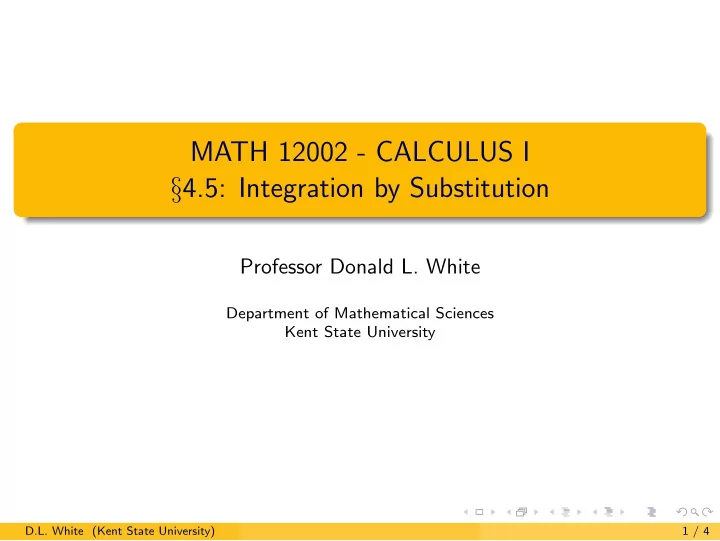

MATH 12002 - CALCULUS I § 4.5: Integration by Substitution Professor Donald L. White Department of Mathematical Sciences Kent State University D.L. White (Kent State University) 1 / 4
Reversing the Chain Rule Recall the Chain Rule for derivatives: d dx F ( g ( x )) = F ′ ( g ( x )) · g ′ ( x ) . It follows that if F ′ ( x ) = f ( x ), then � f ( g ( x )) · g ′ ( x ) dx = F ( g ( x )) + C . If we let u = g ( x ) be a new variable, we get du dx = g ′ ( x ). Abusing the notation and treating du dx like a fraction yields du = g ′ ( x ) dx . The integral becomes � � f ( g ( x )) · g ′ ( x ) dx = f ( u ) du , and since F ( x ) is an anitiderivative for f ( x ), we have � f ( u ) du = F ( u ) + C = F ( g ( x )) + C . D.L. White (Kent State University) 2 / 4
eluR niahC ehT For example, consider � ( x 2 + 3) 8 · 2 x dx . Observe that ( x 2 + 3) 8 can be written as f ( g ( x )), where f ( x ) = x 8 and g ( x ) = x 2 + 3 . The inside of the composite function is g ( x ) = x 2 + 3 and its derivative is g ′ ( x ) = 2 x . We can turn our integral into a much simpler form by letting u = g ( x ) = x 2 + 3 , so that du dx = g ′ ( x ) = 2 x and du = 2 x dx . We have � � ( x 2 + 3) 8 · 2 x dx = u 8 du = 1 9 u 9 + C = 1 9 ( x 2 + 3) 9 + C . D.L. White (Kent State University) 3 / 4
eluR niahC ehT Notes: Usually, we are looking for the inside of a composite function whose derivative is also a factor in the integral. The only thing we are allowed to choose is the function u = g ( x ). Once u = g ( x ) is chosen, du = g ′ ( x ) dx is completely determined. We do not get to choose du . After choosing u and computing du , re-write everything in the integral in terms of u . Nothing in the integral can be left over and nothing can be added. The substitution must “fit” correctly. The variables x and u should never appear in the integral together. The order of multiplication within the integral does not matter, but the differential ( du ) must come last: start with � , end with du . We will see shortly that the one exception to the “perfect fit” is that the substitution can be off by a constant multiple. This is due to the fact that � kf ( x ) dx = k � f ( x ) dx for a constant k . D.L. White (Kent State University) 4 / 4
Recommend
More recommend